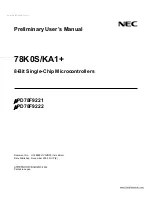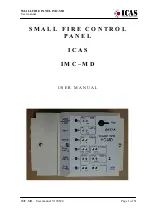
Date Code 990430
Loss-of-Potential, Load Encroachment, and Directional Element Logic
4-21
SEL-351P Manual Técnico
Directional Elements
Refer to Figure SECTION 4: .16, Figure SECTION 4: .17, and Figure SECTION 4: .18.
If enable setting ELOP = Y or Y1 and a loss-of-potential condition occurs (Relay Word bit LOP
asserts), the negative-sequence voltage-polarized and positive-sequence voltage-polarized
directional elements are disabled (see Figure SECTION 4: .17 and Figure SECTION 4: .18).
Refer to Figure SECTION 4: .1 and accompanying text for more information on loss-of-
potential.
Note in Figure SECTION 4: .16 and Figure SECTION 4: .18, that the assertion of internal
enable 32QE (for the negative-sequence voltage-polarized directional element) disables the
positive-sequence voltage-polarized directional element. The negative-sequence voltage-
polarized directional element has priority over the positive-sequence voltage-polarized
directional elements in controlling the phase overcurrent elements. The negative-sequence
voltage-polarized directional element operates for unbalanced faults while the positive-sequence
voltage-polarized directional element operates for three-phase faults.
Note also in Figure SECTION 4: .18 that the assertion of ZLOAD disables the positive-sequence
voltage-polarized directional element. ZLOAD asserts when the relay is operating in a user-
defined load region (see Figure SECTION 4: .2).
Directional Element Routing
Refer to Figure SECTION 4: .16 and Figure SECTION 4: .19.
The directional element outputs are routed to the forward (Relay Word bits 32QF and 32PF) and
reverse (Relay Word bits 32QR and 32PR) logic points and then on to the direction
forward/reverse logic in Figure SECTION 4: .20 and Figure SECTION 4: .21.
Loss-of-Potential
Note if both the following are true:
•
Enable setting ELOP = Y,
•
A loss-of-potential condition occurs (Relay Word bit LOP asserts),
then the forward logic points (Relay Word bits 32QF and 32PF) assert to logical 1, thus, enabling
the negative-sequence and phase overcurrent elements that are set direction forward (with
settings DIR1 = F, DIR2 = F, etc.). These direction forward overcurrent elements effectively
become nondirectional and provide overcurrent protection during a loss-of-potential condition.
As detailed previously (in Figure SECTION 4: .17 and Figure SECTION 4: .18), voltage-based
directional elements are disabled during a loss-of-potential condition. Thus, the overcurrent
elements controlled by these voltage-based directional elements are also disabled. But this
disable condition is overridden for the overcurrent elements set direction forward if setting
ELOP = Y.
Refer to Figure SECTION 4: .1 and accompanying text for more information on loss-of-
potential.
Summary of Contents for SEL-351P
Page 6: ......
Page 92: ......
Page 96: ......
Page 154: ......
Page 156: ......
Page 222: ......
Page 258: ......
Page 262: ......
Page 324: ......
Page 368: ......
Page 406: ......
Page 482: ......
Page 534: ......
Page 539: ......
Page 549: ......
Page 551: ......
Page 587: ......
Page 597: ......
Page 601: ......
Page 603: ......
Page 609: ......
Page 621: ......
Page 635: ......
Page 649: ......
Page 665: ......
Page 671: ......
















































